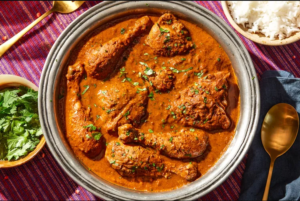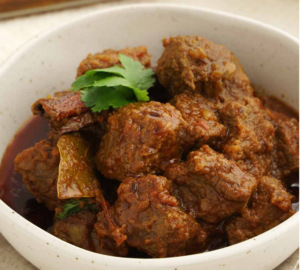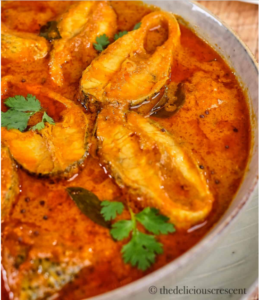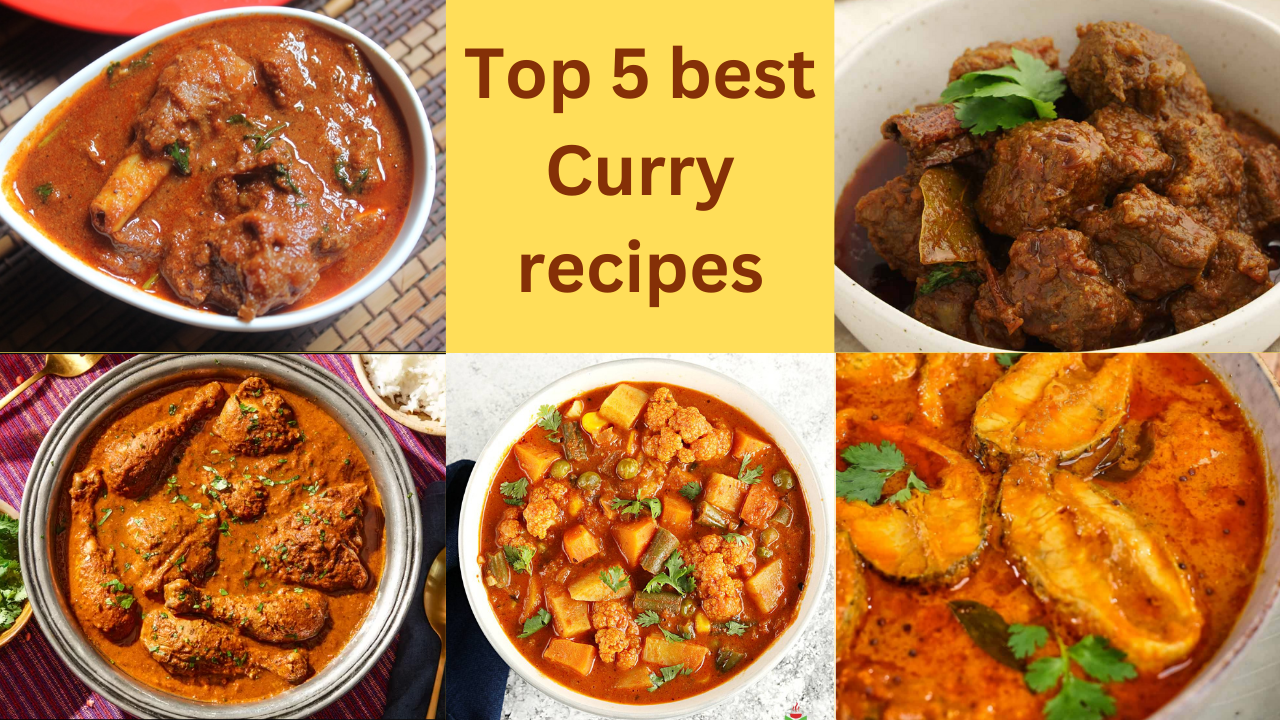Introduction of curry :
Curry is a delicious and aromatic dish that has its roots in the traditional cuisine of the Indian subcontinent. However, curry has become a global phenomenon, with many different interpretations and adaptations found in cuisines around the world. Essentially, curry refers to a dish made from a mixture of spices, herbs, vegetables, meat, and legumes and cooked with gravy or gravy. The term "curry" itself is believed to be derived from the Tamil word "kali", meaning sauce. recipe recipe recipe
NO 1 : Chicken Curry recipe :
Introduction of Chicken curry recipe :
Chicken curry is a popular dish enjoyed in many different cuisines around the world, known for its rich flavor, aromatic spices, and tender chicken cooked in a flavorful sauce. Although there are countless variations of chicken curry recipes, this introduction provides an overview of the classic Indian chicken curry, highlighting its key ingredients, cooking methods, and cultural significance.

Ingredients :
-
Chicken: The main ingredient of chicken curry is, of course, chicken. Bone-in pieces such as thighs, drumsticks, or breasts are commonly used, providing succulent meat that absorbs the flavors of the curry sauce. -
Tomatoes: Tomatoes add a tangy sweetness and help create the rich texture of the curry sauce. They can be used fresh, canned, or in the form of tomato paste. -
Spices: A blend of aromatic spices is essential for authentic chicken curry. Common spices include cumin, coriander, turmeric, chili powder, garam masala, and whole spices such as cinnamon, cloves, and cardamom pods. -
Yogurt or Coconut Milk: Depending on the regional variation, chicken curry may include either yogurt or coconut milk to add creaminess and balance the spices. Yogurt provides a tangy flavor, while coconut milk offers a slightly sweet and nutty taste. -
Ghee or Oil: Ghee (clarified butter) or oil is used for sautéing the aromatics and spices, adding richness and depth of flavor to the dish.
Instruction :
Saute Flavor: In a large pot or skillet, heat the ghee or oil over medium-high heat. Fry the chopped onion until transparent, then add the chopped garlic and ginger and fry until fragrant.
Add spices: Once the flavors have settled, add ground spices (such as cumin, coriander, turmeric, and chili powder) and whole spices (such as cinnamon, cloves, and cardamom) to the pot. The spices are lightly roasted to bring out their aroma.
Cook the chicken: Add the chicken to the pot and coat evenly with the spice mixture. Lightly brown the chicken on all sides to retain its juices and flavor.
Simmer with tomatoes: Make a curry sauce by mixing chopped tomatoes or tomato paste with a little water or chicken stock. Cover the pot and simmer until the chicken is tender.
Add yogurt or coconut milk: Depending on the recipe, you can add yogurt or coconut milk to the curry sauce to achieve the desired consistency and creaminess.
Adjust seasoning: Taste the curry and adjust seasoning with salt, pepper, or additional spices as needed. You can also add a squeeze of lemon juice or a pinch of fresh cilantro for an extra boost of flavor.
Serving: Chicken curry is usually served hot with rice, naan, or roti. Garnish with fresh coriander leaves or a little yogurt before serving.
NO 2 : Beef Curry recipe :
Introduction :
Beef curry is a hearty and delicious dish that is enjoyed in a variety of cuisines around the world and is known for its tender beef cooked in a rich, flavorful sauce. This introduction provides an overview of the classic beef curry recipe, highlighting its key ingredients, cooking methods, and cultural significance.

Ingredients :
-
Beef: The star ingredient of beef curry is, of course, beef. Cubes of beef chuck or stewing beef are commonly used for their tenderness and ability to absorb the flavors of the curry sauce. -
Aromatics: Onions, garlic, and ginger form the aromatic base of the curry sauce. They are finely chopped or blended into a paste to create a flavorful foundation for the dish. -
Tomatoes: Tomatoes add a tangy sweetness and help create the rich texture of the curry sauce. They can be used fresh, canned, or in the form of tomato paste. -
Spices: A blend of aromatic spices is essential for authentic beef curry. Common spices include cumin, coriander, turmeric, chili powder, garam masala, and whole spices such as cinnamon, cloves, and cardamom pods. -
Yogurt or Coconut Milk: Depending on the regional variation, beef curry may include either yogurt or coconut milk to add creaminess and balance the spices. Yogurt provides a tangy flavor, while coconut milk offers a slightly sweet and nutty taste. -
Ghee or Oil: Ghee (clarified butter) or oil is used for sautéing the aromatics and spices, adding richness and depth of flavor to the dish.
Instruction :
Saute Flavor: In a large pot or skillet, heat the ghee or oil over medium-high heat. Fry the chopped onion until transparent, then add the chopped garlic and ginger and fry until fragrant.
Add spices: Once the flavors have settled, add ground spices (such as cumin, coriander, turmeric, and chili powder) and whole spices (such as cinnamon, cloves, and cardamom) to the pot. The spices are lightly roasted to bring out their aroma.
Cook the beef: Add the beef cubes to the pot and coat evenly with the spice mixture. Lightly brown the beef on all sides to retain its juices and flavor.
Cook with tomatoes: Make a curry sauce by mixing chopped tomatoes or tomato paste with a little water or beef stock. Cover the pot and simmer until the beef is cooked through and tender.
Add yogurt or coconut milk: Depending on the recipe, you can add yogurt or coconut milk to the curry sauce to achieve the desired consistency and creaminess.
Adjust seasoning: Taste the curry and adjust seasoning with salt, pepper, or additional spices as needed. You can also add a squeeze of lemon juice or a pinch of fresh cilantro for an extra boost of flavor.
Serving: Beef curry is usually served hot with rice, naan, or roti. Garnish with fresh coriander leaves or a little yogurt before serving.
NO 3 : Mutton Curry recipe :
Introduction :
Mutton curry is a classic dish enjoyed in many traditional cuisines around the world, known for its bold flavor, tender mutton, and aromatic spices.

Ingredients :
-
Mutton: Mutton, or mature sheep meat, is the primary ingredient in mutton curry. It offers a rich and distinctive flavor that pairs well with the spices and other ingredients in the curry. -
Tomatoes: Tomatoes add acidity and sweetness to the curry sauce while helping to create a rich and thick consistency. They can be used fresh, canned, or in the form of tomato paste. -
Spices: A blend of aromatic spices is essential for authentic mutton curry. Common spices include cumin, coriander, turmeric, chili powder, garam masala, and whole spices such as cinnamon, cloves, and cardamom pods. -
Yogurt or Coconut Milk: Depending on the regional variation, mutton curry may include either yogurt or coconut milk to add creaminess and balance the spices. Yogurt provides a tangy flavor, while coconut milk offers a slightly sweet and nutty taste. -
Ghee or Oil: Ghee (clarified butter) or oil is used for sautéing the aromatics and spices, adding richness and depth of flavor to the dish.
Instruction :
Saute Flavor: In a large pot or skillet, heat the ghee or oil over medium-high heat. Fry the chopped onion until transparent, then add the chopped garlic and ginger and fry until fragrant.
Add spices: Once the flavors have settled, add ground spices (such as cumin, coriander, turmeric, and chili powder) and whole spices (such as cinnamon, cloves, and cardamom) to the pot. The spices are lightly roasted to bring out their aroma.
Cook the mutton: Add mutton pieces to the pan and coat evenly with the spice mixture. Wait until the mutton is slightly browned on all sides, preserving its juices and flavour.
Stew with tomatoes: Make a curry sauce by mixing chopped tomatoes or tomato paste with a little water or mutton stock. Cover the pot and simmer the mutton until tender.
Add yogurt or coconut milk: Depending on the recipe, you can add yogurt or coconut milk to the curry sauce to achieve the desired consistency and creaminess.
Adjust seasoning: Taste the curry and adjust seasoning with salt, pepper, or additional spices as needed. You can also add a squeeze of lemon juice or a pinch of fresh cilantro for an extra boost of flavor.
Serving: Mutton curry is usually served hot with rice, naan, or roti. Garnish with fresh coriander leaves or a little yogurt before serving.
NO 4 : Fish Curry recipe :
Introduction :
Fish curry is a dish celebrated in many culinary traditions around the world, offering a symphony of flavors to tantalize your taste buds. This introduction provides a glimpse into the essence of fish curry, highlighting its cultural significance, key ingredients, and cooking methods.

Ingredients :
-
Fish: The star of the dish, fish lends its delicate flavor and tender texture to the curry. Varieties of fish used in curry include tilapia, salmon, cod, snapper, or mackerel, chosen based on availability and regional preferences. -
Aromatics: Aromatic ingredients such as onions, garlic, and ginger form the flavor base of the curry, infusing it with depth and complexity. -
Spices: A harmonious blend of spices is crucial for creating the distinctive flavor profile of fish curry. Common spices include cumin, coriander, turmeric, chili powder, and fenugreek seeds, along with whole spices such as cinnamon, cardamom, and cloves. -
Tomatoes or Tamarind: Tomatoes or tamarind pulp contribute tanginess to the curry, balancing the richness of the spices and enhancing the overall flavor. -
Coconut Milk or Yogurt: Coconut milk or yogurt adds creaminess to the curry, imparting a luscious texture and subtle sweetness. -
Fresh Herbs: Fresh herbs like cilantro or curry leaves are often used as garnishes, adding a burst of freshness and aroma to the finished dish
Instruction :
Step 1 : Heat the vegetable oil in a large skillet or frying pan over medium-high heat. Add cumin and whisk.
Step 2 : Add the chopped onions to the pan and fry until golden brown.
Step 3 : Add the minced garlic and grated ginger and stir-fry for another 1-2 minutes until fragrant.
Step 4 : Add the chopped tomatoes to the pot and cook until they soften and release their juices.
Step 5 : Add coriander powder, turmeric powder, red chili powder and garam masala and mix. Cook the spices for 1 minute to release their flavor.
Step 6 : Add the coconut milk and bring the mixture to a gentle simmer. Wait about 5 minutes until the flavors meld.
Step 7 : Season the sauce with salt. Carefully add the fish fillets to the pot, making sure they are submerged in the sauce.
Step 8 : Cover the pot and simmer the fish in the curry sauce for about 8 to 10 minutes, or until the fish is cooked through and flakes easily with a fork.
Step 9 : Once the fish is cooked, remove the pot from the heat.
Step 10 : Garnish the fish curry with fresh coriander leaves before serving.
Step 11 : Enjoy with hot rice or naan.
.
NO 5 : Vegetable Curry :
Introduction :
Vegetable curry is a vibrant, flavorful dish that celebrates the rich diversity of vegetables and spices, offering a delicious culinary experience for vegetarians and vegans alike.

Ingredients :
-
Assorted Vegetables: The beauty of vegetable curry lies in its diversity of vegetables, which can include potatoes, carrots, bell peppers, cauliflower, peas, spinach, eggplant, and more. The choice of vegetables may vary based on seasonal availability and personal preferences. -
Fresh herbs like cilantro or curry leaves may also be used to enhance the flavor profile. -
Spices: A blend of spices is essential for creating the distinctive flavor profile of vegetable curry. Common spices include cumin, coriander, turmeric, chili powder, garam masala, and fenugreek seeds, along with whole spices such as cinnamon, cardamom, and cloves. -
Tomatoes or Coconut Milk: Tomatoes provide acidity and sweetness to the curry sauce, while coconut milk adds richness and creaminess. Both ingredients contribute to the overall flavor and texture of the dish. -
Protein: Some vegetable curry recipes may include protein sources such as tofu, chickpeas, lentils, or paneer (Indian cottage cheese) to add substance and nutritional value to the dish.
Instruction :
Step 1 : Heat vegetable oil in a large skillet or saucepan over medium heat. Add the chopped onions and fry until transparent.
Step 2 : Add the minced garlic and grated ginger and stir-fry for another minute until fragrant.
Step 3 : Add the chopped tomatoes to the pot and cook until they soften and fall apart, creating a thick sauce.
Step 4 : Mix curry powder, turmeric powder, cumin powder and coriander powder. Cook the spices for 1 minute to release their flavor.
Step 5 : Add the diced potatoes, carrots, bell pepper, cauliflower florets, and green peas to the pot.
Step 6 : Add coconut milk and stir. Simmer the curry slowly.
Step 7 : Cover the pot and simmer in the curry sauce until the vegetables are tender, about 15 to 20 minutes. Stir occasionally to prevent sticking.
Step 8 : As soon as the vegetables are cooked, check the taste of the curry and adjust the taste with salt if necessary.
Step 9 : Garnish the vegetable curry with fresh coriander leaves before serving.
Step 10 : Enjoy with hot rice or naan.
recipe recipe recipe reciperecipereciperecipereciperecipereciperecipereciperecipereciperecipereciperecipereciperecipereciperecipereciperecipe recipe recipe vreciperecipereciperecipe
